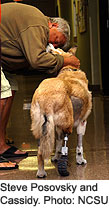
THURSDAY, April 29 (HealthDay News) — An injury prevented Juniper from walking normally. Frostbite damaged the hind legs of Meadow. And Andre gnawed off his paws to escape from a wolf trap.
Until a few years ago, there wasn’t much hope for these and other disabled animals of ever leading normal lives again. But thanks to advancements in veterinary medicine, and the small but growing field of animal prosthetics, it’s now possible for pets and farm animals with missing limbs to walk, run and romp on all four legs.
Cassidy, a shepherd mix, with a caramel-colored coat, was recently outfitted with a carbon fiber leg similar to ones that amputee runners use.
“We just came back from the beach and he’s able to run all day,” said Cassidy’s owner, Steve Posovsky, a retired dentist in Delray Beach, Fla.
The adopted stray — found wandering the streets of the Bronx on three legs — is a medical pioneer, becoming the first dog to successfully undergo osseointegration orthopedic surgery, a procedure that may one day benefit humans.
During the four-hour operation, a titanium implant was inserted into Cassidy’s right hind leg bone — designed by veterinarian Denis Marcellin-Little and his colleagues at North Carolina State University in Raleigh — so that a custom prosthetic limb could later be screwed into the visible tip. The result is an artificial leg that behaves more like a natural limb.
“It’s not that different from a total joint replacement,” said Marcellin-Little of the surgery. “And, clearly, we have a lot of experience fixing joint prosthetics to bone. That’s done in hundreds of thousands of people each year worldwide.”
Since Cassidy’s surgery in July 2008, a handful of veterinarians in the United States and Europe have used osseointegration to replace limbs of other family dogs and cats.
Marcellin-Little, a professor of orthopedics, currently has three patients — all dogs that will soon undergo the $7,000 procedure that replaces a missing lower extremity of an otherwise healthy leg.
Entire limbs cannot be replaced, he said.
In Cassidy’s case, it’s taken 18 months between the surgery and receiving his permanent prosthetic leg in March.
“It’s not simple, cheap or quick,” Marcellin-Little said of the process.
That’s because all equipment is designed and hand-built for each patient, and the experimental surgery must be rehearsed beforehand to make sure it goes smoothly.
It takes around three months of healing time before weight is put on the leg; the animal then must re-learn how to walk on all four feet.
For six weeks, Posovsky patiently helped Cassidy inch across the bedroom, putting one leg in front of the other. The hours upon hours of training finally paid off when one morning Cassidy began to walk on his own.
For most animal owners, externally attached prosthetics are a faster, less-expensive option.
OrthoPets, in Denver, manufactures prosthetics and braces for about 1,200 animals worldwide each year. Most are dogs, but they’ve also worked with cats, cows, birds, llamas, horses, even an orangutan.
“We joke that if it has an appendage and a heartbeat, we can usually help out,” said Amy Kaufmann.
She started the business six years ago with her husband, Martin, who previously worked in the human prosthetics field.
The external prosthetics are built to “last a lifetime” by using tough industrial grade plastic, said Kaufmann. To combat chafing and irritation the devices are lined with special color-changing foam that turns black, alerting owners if a problem arises.
For an animal to be outfitted with an artificial limb, which is attached with straps, Kaufmann said front legs must still have the elbow joint and part of the radius and ulna. The knee joint, as well as part of the tibia and fibula, must be present on rear legs.
Prosthetics for cats and dogs cost between $600 and $800. The price for larger animals, such as cows, llamas and horses, ranges from $800 to $2,000.
For Cassidy, the three-legged shepherd, even the most sophisticated external prosthetic didn’t work. Marcellin-Little made two different artificial limbs for him. But because of Cassidy’s odd-shaped leg, the devices didn’t stay on.
That’s when Posovsky and his wife, Susan, decided to move forward with osseointegration, in hopes of giving their dog the joy of being able to go for long walks with them on the beach.
“Cassidy had every reason not to be a nice dog, and have an attitude,” said Posovsky of the practically hairless mutt he adopted from the pound. “But this dog — you can’t even make him mad if you tried. That’s how sweet he is. He is just the most wonderful, deserving, loving animal there is.”
More information
For more on animal amputation, go to the American College of Veterinary Surgeons.

